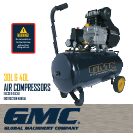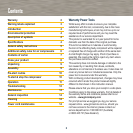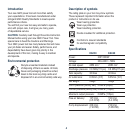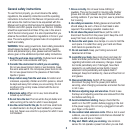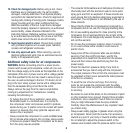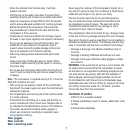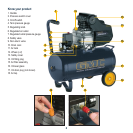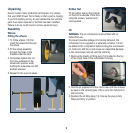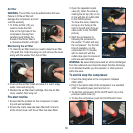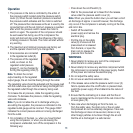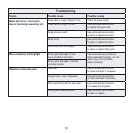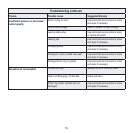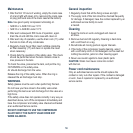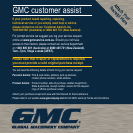6
18. Check for damaged parts. Before using a tool, check
that there are no damaged parts. If a part is slightly
damaged, carefully determine if it will operate properly
and perform its intended function. Check for alignment of
moving parts, binding of moving parts, breakage of parts,
proper mounting and any other conditions that may
affect the operation of the tool. A part that is damaged
should be properly repaired or replaced by an authorised
service facility, unless otherwise indicated in this
Instruction Manual. Defective switches must be replaced
by an authorised service facility. Do not use a tool if the
switch does not turn the tool on and off correctly.
19. Guard against electric shock. Prevent body contact
with grounded objects such as water pipes, radiators,
cookers and refrigerator enclosures.
20. Use only approved parts. When servicing, use only
identical replacement parts. Use an authorised service
facility to fit replacement parts.
Additional safety rules for air compressors
WARNING. Before connecting a tool to a power source
(mains switch power point receptacle, outlet, etc.) be sure
that the voltage supply is the same as that specified on the
nameplate of the tool. A power source with a voltage greater
than that specified for the tool can result in serious injury to
the user, as well as damage to the tool. If in doubt, do not
plug in the tool. Using a power source with a voltage less
than the nameplate rating is harmful to the motor.
Always remove the plug from the mains socket before
making any adjustments or maintenance, including
renewing the lubricating oil.
• To reduce the risk of fire or explosion, never spray
flammable liquids in a confined area. It is normal for
the compressor motor and pressure switch to produce
sparks during use. If sparks come into contact with petrol
vapours or solvents, they may ignite the vapours and
cause a fire or explosion.
• Always operate the compressor in a well ventilated area.
Do not smoke while spraying. Do not spray where sparks
or flames are present. Keep the compressor as far away
from the spray area as possible.
• The solvents trichloroethane and methylene chloride can
chemically react with the aluminium used in some paint
spray guns and form an explosion. If these solvents are
used, ensure that only stainless steel spray equipment is
connected. The compressor is not affected by the use of
these solvents.
• Never directly inhale the compressed air produced by a
compressor and do not use it for charging breathing tanks.
• Do not use welding equipment in close proximity to the
compressor. Do not weld anything to the air tank of the
compressor: this could dangerously weaken the tank and
will void the warranty.
• Do not use the compressor outdoors when it is raining
or on a wet surface; either situation could cause an
electric shock.
• Always shut off the compressor after use and before
servicing. Push the on/off knob down, wait for the
pressurised air to bleed from the tank from the release
valve and then remove the electrical plug from the
power supply.
• Check the maximum pressure rating of any tools or
accessories that you intend using with the compressor.
The output pressure of the air from the compressor must
be regulated so that it never exceeds the rated pressure
of the tool or accessory.
• To avoid the risk of burns and injury from moving
parts, do not operate the compressor with the safety
cover removed. Allow hot parts to cool before handling
or servicing.
• Be certain to read all the labels on the containers of paint
or other materials to be sprayed. Closely follow all safety
instructions. Use a respirator mask if there is a chance
that you might otherwise inhale the spray material.
Carefully check the effectiveness of any respirator mask
you intend using.
• Always wear safety goggles or glasses when using the
air compressor. Never point the nozzle of an accessory
towards any part of your body or towards another person.
• Do not attempt to adjust the pressure switch or the
release valve located under the pressure switch cover.



